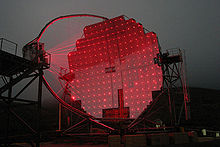Very-high-energy gamma ray

Very-high-energy gamma ray (VHEGR) denotes
Detection
Instruments to detect this radiation commonly measure the
Air showers of elementary particles made by gamma rays can also be distinguished from those produced by cosmic rays by the much greater depth of shower maximum, and the much lower quantity of muons.[7]
Very-high-energy gamma rays are too low energy to show the Landau–Pomeranchuk–Migdal effect. Only magnetic fields perpendicular to the path of the photon causes pair production, so that photons coming in parallel to the geomagnetic field lines can survive intact until they meet the atmosphere. These photons that come through the magnetic window can make a Landau–Pomeranchuk–Migdal shower.[9]
| Class | energy | energy | energy | frequency | wavelength | comparison | properties |
|---|---|---|---|---|---|---|---|
| eV | eV | Joules | Hertz | meters | |||
| 1 | 1 | 0.1602 aJ |
241.8 THz | 1.2398 μm | near infrared photon | for comparison | |
| 100 GeV | 1 × 1011 | 0.01602 μJ | 2.42 × 1025 Hz | 1.2 × 10−17 m | Z boson | ||
| Very-high-energy gamma rays | |||||||
| 1 TeV | 1 × 1012 | 0.1602 μJ | 2.42 × 1026 Hz | 1.2 × 10−18 m | flying mosquito | produces Cherenkov light | |
| 10 TeV | 1 × 1013 | 1.602 μJ | 2.42 × 1027 Hz | 1.2 × 10−19 m | air shower reaches ground | ||
| 100 TeV | 1 × 1014 | 0.01602 mJ | 2.42 × 1028 Hz | 1.2 × 10−20 m | ping pong ball falling off a bat | causes nitrogen to fluoresce | |
| Ultra-high-energy gamma rays | |||||||
| 1 PeV | 1 × 1015 | 0.1602 mJ | 2.42 × 1029 Hz | 1.2 × 10−21 m | |||
| 10 PeV | 1 × 1016 | 1.602 mJ | 2.42 × 1030 Hz | 1.2 × 10−22 m | potential energy of golf ball on a tee | ||
| 100 PeV | 1 × 1017 | 0.01602 J | 2.42 × 1031 Hz | 1.2 × 10−23 m | penetrate geomagnetic field | ||
| 1 EeV | 1 × 1018 | 0.1602 J | 2.42 × 1032 Hz | 1.2 × 10−24 m | |||
| 10 EeV | 1 × 1019 | 1.602 J | 2.42 × 1033 Hz | 1.2 × 10−25 m | air rifle shot |
Importance
Very-high-energy gamma rays are of importance because they may reveal the source of
The ratio of primary cosmic ray hadrons to gamma rays also gives a clue as to the origin of cosmic rays. Although gamma rays could be produced near the source of cosmic rays, they could also be produced by interactions with the cosmic microwave background by way of the Greisen–Zatsepin–Kuzmin limit cutoff above 50 EeV.[9]
References
- ^ S2CID 122089313
- S2CID 118955434.
- ^ Bibcode:1998AstL...24..134N.
- ^ "Astrophysics with H.E.S.S." Retrieved 26 November 2011.
- ^ "The H.E.S.S. Source Catalog". H.E.S.S. Collaboration. 2011. Retrieved 26 November 2011.
- ^ "High Energy Stereoscopic System". Retrieved 26 November 2011.
- ^ arXiv:0906.0973v1 [astro-ph.HE].
- ^ a b c Aharonian, Felix (24 August 2010). "The Fascinating TeV Sky" (PDF). WSPC - Proceedings. Retrieved 27 November 2011.
- ^ a b Vankov, H. P.; Inoue2, N.; Shinozaki, K. (2 February 2008). "Ultra-High Energy Gamma Rays in Geomagnetic Field and Atmosphere" (PDF). Retrieved 3 December 2011.
{{cite web}}: CS1 maint: numeric names: authors list (link)

